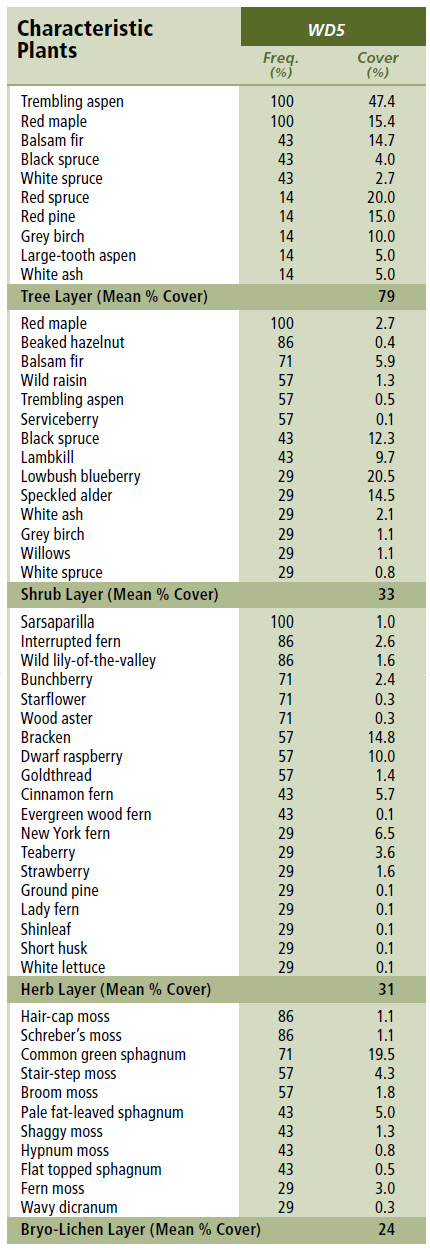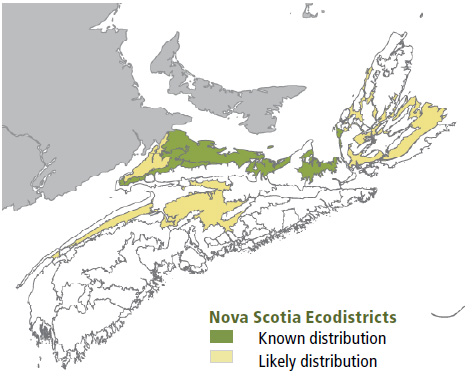
Forest Vegetation types - WD5
WD5 — Trembling aspen / Beaked hazelnut / Interrupted fern / phagnum
Populus tremuloides / Corylus cornuta /Osmunda claytoniana / Sphagnum spp.
 |
Wallace Bay, Cumberland County |
Concept: Poorly drained flats and gentle slopes support this relatively uncommon wet forest, which is characterized by trembling aspen canopy dominance and high sphagnum cover. This is the wettest trembling aspen forest in Nova Scotia. Red maple is a frequent but lesser canopy component, while balsam fir and/or spruce are occasionally present with low cover.
Vegetation: Canopy layers are strongly dominated by trembling aspen or co-dominated by trembling aspen and red maple. Small patches or scattered balsam fir and spruce (usually red) are not uncommon. Black ash is infrequently a component of this forest type, but may be restricted to the understory. Lower woody layers are moderately well developed but largely dominated by regenerating canopy species; beaked hazelnut is the only characteristic shrub. Interrupted fern, wood aster, dwarf raspberry and several common upland forest species comprise the sometimes sparse herbaceous layer. Bryophyte abundance is similar, and only common green sphagnum is prominent.
Environmental Setting: WD5 is mainly found in the Northumberland/Bras d’Or ecoregion, but can occur in other parts of the mainland Nova Scotia. This low elevation ecosystem is usually on poorly drained flats or lower slopes, with moderate exposure. Most sites have little surface stoniness or exposed bedrock, but slight microtopography. WD5 sites are associated with low to moderate nutrient availability, shallow to moderate rooting potential and moderate humus accumulation. Both mineral and organic soils can be found, but mineral substrates (of variable texture) are more common. WD5 is widespread in northern Prince Edward Island and across both southwestern and eastern New Brunswick.
Successional Dynamics: This is an early-successional forest but wet soils limit its potential for successional development. Depending on disturbance history, site fertility and nearby seed sources, WD5 could maintain itself or succeed to WD3 (Red maple / Sensitive fern – Lady fern / Sphagnum), WD7 (Balsam fir – White ash / Cinnamon fern – New York fern / Sphagnum) or WD8 (Red spruce – Red maple / Wood sorrel – Sensitive fern / Sphagnum). Windthrow and harvesting are the main stand-level disturbance agents. This Vegetation Type (VT) usually originates from agricultural land clearing or clearcutting.
Ecological Features: Despite its relative scarcity, this small-patch VT has somewhat low conservation value. Most stands originate through farming and show signs of fertilizer pollution, erosion and hydrologic alteration. However, in many agricultural landscapes, young seral forests, such as WD5, provide the only notable habitat for some wildlife. For example, aspen leaves, twigs and bark are highly nutritious, providing an important food source, while the tree’s soft wood is easily excavated by cavity nesters. This ecosystem’s potential for self-renewal from root suckering is high, provided that erosion and pollution inputs are minimized. The VT occurs in small to medium sized basins or in small perched depressions. Stands are usually very productive, but no species of conservation concern were found in available plot data. Similar to other wetlands, WD5 contributes to carbon, nitrogen and water budgets and helps regulate groundwater quality and flow.
 |
| Interrupted fern |
Distinguishing Features: This is a poorly drained forest dominated by trembling aspen. Beaked hazelnut is characteristic of the shrub understory. Bracken, dwarf raspberry and common green sphagnum are the most abundant of an otherwise sparsely-developed herb and moss layers.
| Slope Position: | Level6 Lower4 |
Surface Stoniness: |
(Non - Slightly)10 |
Bedrock Outcrop: |
(Non-rocky)10 |
Elevation Range: |
9 - 87m |
Slope Gradient: |
Level6 Gentle4 |
Aspect: |
North3 East3 None4 |
Exposure: |
Moderate10 |
Microtopography: |
Level5 Slightly4 Strongly1 |
Drainage: |
Poor7 Imperfect3 |
Soil Type: |
ST44 ST74 ST102 |
Parent Material: |
Glacial till9 Lacustrine1 |
Rooting Depth (cm): |
(<30)3 (30-45)6 nd1 |
Duff Thickness (cm): |
(0-5)3 (6-10)4 (11-20)3 |

